TDS Telecom delivers ADSL - a dream come true
March 15, 2008 After 8 years of wishing for true low-latency broadband on Beaver Island, TDS has come through in a big way and delivered 1.5 and 3.0 mbps / 512 kbps DSL broadband at last. If anyone is interested in broadband within the following coverage areas, this is the best option we have ever experienced on Beaver Island! - St. James, the Port St. James area including Donegal Bay,
- Carlisle Road,
- Barney's Lake Road North from ~27996 to Four Corners,
- King's Highway,
- Paid een Og's Road, and
- East Side Drive from ~31080 north to Four Corners (including roads originating from East Side Drive between these points.)
Click here for more information, prices and plans, and real-world performance.
Wildblue/Hughes still better than dialup by a long shot...
October 18, 2007
With no real progress made this summer for out-of-towners, at least satellite options provide "satellite speed" Internet that is much better than dialup. While things are a bit of a gamble on either system depending on satellite and gateway configuration at a particular time, unless money is very tight satellite does provide a reasonable better-than-dialup solution that is available here and now. (the only drawback is the contract length, so again a bit of a gamble whether the better wireless system will accelerate and reach you before the completion of the minimum contract-length.) Wildblue went through a period from November of 2006 through the spring of 2007 where performance was degraded and I questioned the monthly cost, but performance has stabilized again as of this summer of 2007 and is pretty reliably fast this fall. And there's no comparison to dialup when any heavy lifting is involved (software updates, music, video, browsing photography-rich sites, etc.), though I'll take wireless the moment it reaches Barney's Lake. Thanks to Wildblue for providing a decent solution in the meantime. 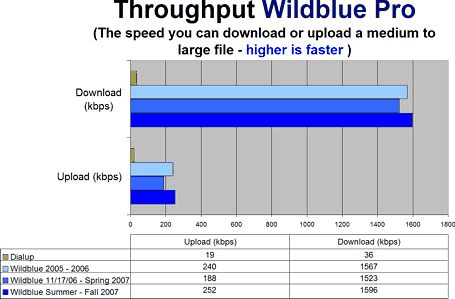
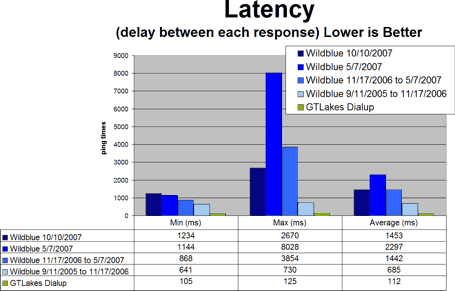
Correction: Almost: Slow-moving County Planning Commission process still ongoing into winter
October 17, 2007
At their respective St. James and Peaine Township October meetings, the Town Boards accepted the three proposed zoning changes (the increase in tower height, the formal allowing of residences to be rented, and the establishment of an adult-business zone), and approved sending them on to the County Planning Commission for approval. To not impede tower construction for this fall, the Peaine Board also voted to allow construction to start on the tower at the East Side Drive Fire Hall despite the extremely slow-moving County Planning Commission process.
Zoning passes Township level - the ball is now in Central Solutions' Court again and things are looking up!
October 10, 2007
This summer was spent with the planning commissions working diligently though an excruciatingly long process to update the zoning ordinance that put the breaks on technological progress for the Island beyond the town of St. James. No one to date has been able to actually demonstrate lower frequency NLOS wireless to work on the Island using only smaller towers, so Central Solutions' broadband plan requires a couple towers taller than 99' to give the system any reach, one planned for the Peaine Township Fire Station to serve the Sand Bay area and another adjacent to the St. James septic mound property on Donegal Bay Road to serve the Port St. James area. At last, in October both Townships approved the changes that went through the local Planning Commissions in late September, so the zoning changes have now cleared the Township level with agreement at the local level on all provisions. Rumor on the street is also that Central Solutions has financial backing now to proceed. (Thank you to the investor who had the vision to invest in this project which may take some time to yield a return but will no doubt be as fundamental as telephone and electiricty in the decade to come). The ball is finally in Central Solutions Court again and we look forward to seeing what they can accomplish to bring Peaine and all the out-of-town areas of the Island into the 21st century.
Slow Zoning Process stalls summer deployment of two towers necessary for Central Solutions to reach beyond town
June 15, 2007 Existing zoning restrictions and the long, slow process necessary to update the zoning ordinance have stalled tower construction necessary to reach out of town. At this point, it appears it will take longer than mid-summer to update the zoning ordinance, so those out of town will have to wait a while longer for any low-latency broadband, possibly only until later this year, or possibly longer still (but while it can be frustrating at times, the slow rate of change is what we all love about the Island too!) Investment money is also still being sought which may or may not be necessary to complete the larger-area project, so it appears we are once again at "a crossroads." In-town however, progress continues along with glitches being worked out and the system getting better by the week. The library still offers a free broadband hotspot, but visitors should very much enjoy the larger full-town internet-access roaming area. And wherever you are, don't hesitate to call (517) 676-4787 or e-mail info@centralsolutions.biz to express your interest. At the bottom of the www.centralsolutions.biz homepage all those in or near town can also signup online!
Central Solutions, Inc. now signing up St. James wireless broadband customers
May 07, 2007 From the May Beacon:
As we go to print, anyone in town now has the option to sign up and receive broadband wireless service from Central Solutions, Inc.!
A wireless link connects the main office at the Eager Beaver on the Highway to the 40' tower (picture) at the Deputy/DNR building on the harbor, from which point the signal is distributed to town. Anyone can also sign up for mobile wifi access in the new "whole town" hotspot with any wireless-capable notebook computer, though further testing as the trees leaf out and also on the water will lead to refinements in the month to come.
Currently, a T1 feeds the project; plans are getting underway to position a tower in the Greene's Lake area which will be able to aim over the trees to reach the mainland. This will provide ample and economical bandwidth as the project expands and also service to customers, a major milestone for the Island as the first low-latency local broadband to reach out of town.
Call (517) 676-4787 or e-mail info@centralsolutions.biz to sign up.
WildBlue & Satellite Internet Status
May 07, 2007 Latency continues to be bad on wildblue since the 11/17/2006 timing slowdown, but raw speeds still make it a good option for file uploads & downloads, listening to streaming music, videos, and other things that are not interactive or latency-sensitive, things that simply don't work or take hours over dialup that can be accomplished quickly over satellite. Wildblue is still better than dialup for browsing anything but text-only pages. It's not so good for secure sites, VPN, and anything encrypted now that latency has increased so drastically.
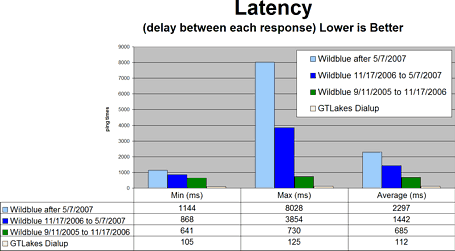 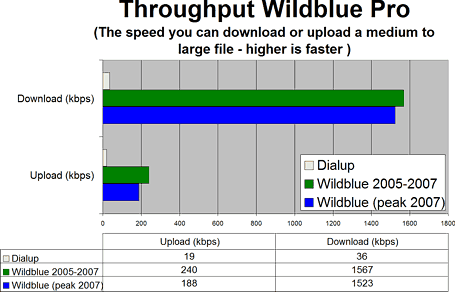
But while in 2005 and 2006, it appeared satellite might be the easy "broadband everywhere," 2007 has been a mixed year for satellite. Many hoped that the new Wildblue 1 satellite launch & corresponding new gateway equipment would bring the return of the initial lower-latency fast satellite network (the ~600-700 ms range originally delivered over wildblue) but so far the new satellite & gateways are being run at the same slower timing as the old to squeeze out more bandwidth per dollar, but with no upgrade path to a higher-performance lower-latency network segment. Further, it appears at this time Beaver Island is in a gap between spotbeams on the new WB1 satellite so will continue to be serviced only by Anik F2. At the same time there have been some interesting changes at hughesnet (formerly direcway) in that their FAP (fair access policy) is now being more heavily enforced. While Wildblue provides a 30-day bandwidth allotment that you can't exceed or else you encounter slow speeds and risk termination, hughesnet previously was much better for high-bandwidth users due to "no penality" for overuse – you were simply fapped until the recovery rate refilled your small x-hour "FAP bucket." Now, however, as of this month, hughesnet has changed their system to slow your speeds dramatically to the point the system is barley usable for 24 hours if you hit the FAP. Since the FAP bucket is much smaller on hughesnet, the probability of hitting this are much greater than on wildblue. So overall, satellite is a mixed bag for 2007. Better than dialup – no question. But far from perfect, and not as bright as when compeition between the two resulted in great new opportuniteis for customers in 2005-2006. 2007 seems to be the year for Satellite providers to tighten the pursestrings and detune the network while keeping customers just happy enough to not drop the service. Tests taken during peak usage period - Monday afternoon 4 PM
Download - 102% of advertised.
Upload - 75% of advertised
Latency - avg 3.5x slower (vs. 2005 wildblue latency)
:::.. Download Stats ..:::
Download Connection is:: 1523 Kbps about 1.5 Mbps (tested with 2992 kB)
Download Speed is:: 186 kB/s
Tested From:: http://testmy.net/ (Server 1)
Test Time:: 2007/05/07 - 1:13pm
Bottom Line:: 27X faster than 56K 1MB Download in 5.51 sec
Tested from a 2992 kB file and took 16.093 seconds to complete
Download Diagnosis:: Looks Great : 4.82 % faster than the average for host (wildblue.net)
D-Validation Link:: http://testmy.net/stats/id-VZDH3AUCM
User Agent:: Mozilla/4.0 (compatible; MSIE 7.0; Windows NT 5.1; .NET CLR 1.1.4322; Alexa Toolbar) [!]
:::.. Upload Stats ..:::
Upload Connection is:: 188 Kbps about 0.2 Mbps (tested with 2992 kB)
Upload Speed is:: 23 kB/s
Tested From:: http://testmy.net/ (Server 1)
Test Time:: 2007/05/07 - 1:19pm
Bottom Line:: 3X faster than 56K 1MB Upload in 44.52 sec
Tested from a 2992 kB file and took 130.579 seconds to complete
Upload Diagnosis:: Awesome! 20% + : 57.98 % faster than the average for host (wildblue.net)
U-Validation Link:: http://testmy.net/stats/id-4K1LBSMD5
User Agent:: Mozilla/4.0 (compatible; MSIE 7.0; Windows NT 5.1; .NET CLR 1.1.4322; Alexa Toolbar) [!]
--- google.com ping statistics ---
25 packets transmitted, 23 received, 8% packet loss, time 24136ms
rtt min/avg/max/mdev = 1144.270/2297.485/8028.174/2035.938 ms
Central Solutions, Inc. holds very positive town meeting
January 18, 2007
The joint township and public meeting with Central Solutions, Inc. was a very positive experience, with Brian Tort of NG Wireless and a representative from both Quality Independent Communications (QUIC), the contractor, and from Proxim Wireless, the equipment vendor, outlining the plan-to-date and their desire for this to be a strongly community-based project in order to get economic tower and radio placements and approvals to make it all happen. Brian explained that instead of going under the name NGWireless, he will now be operating the project under his 2-year old company Central Solutions, Inc. At this point they are looking to secure tower locations, community support, and funding and seek a 60% take rate to achieve an 18-month return on investment. Brian stressed that theirs will be a telco-grade network that "will work just as you expect your telephone to have a dialtone every time you pick it up." The initial promise of availability by April of 2007 has been pushed back to "before the snow falls this winter of 2007" for whole-Island coverage, but the project will start in phases to give them "the flexibility" to incrementally choose the best equipment and strategy for covering each area, provisionally starting again with town this winter/spring and then working around the Island down to the west side and around. An earlier report that NGWireless was looking at all line-of-sight was said to be incorrect: their equipment will be "near line of sight" (the current test signal from the Eager Beaver is reaching the 25 mph sign on the highway and almost to the golf course on the east side) and will also use a range of frequencies including 2.4 Ghz and 900 Mhz.
Provisional plans include:
Residential:
320/320 Kbps: $38.95/month or $28.95/month with a 12-month contract.
512/512 Kbps: $48.95/month or $38.95/month with a 12-month contract.
768/768 Kbps: $58.95/month or $48.95/month with a 12-month contract.
1Mbps/1 Mbps: $88.95/month or $78.95/month with a 12-month contract.
+ $180 or $15/month for 12 months for installation
Small / Home Office (4 IP devices or less):
512/512 Kbps: $69.95/month or $63.60/month with a 12-month contract.
768/768 Kbps: $82.45/month or $74.95/month with a 12-month contract.
1Mbps/1 Mbps: $104.95/month or $95.40/month with a 12-month contract.
+ $210 or $17.50/month for 12 months for installation
Business (5 IP devices or more):
512/512 Kbps: $115.95/month or $100.80/month with a 12-month contract.
768/768 Kbps: $140.95/month or $122.60/month with a 12-month contract.
1Mbps/1 Mbps: $174.95/month or $152.10/month with a 12-month contract.
+ $264 or $22/month for 12 months for installation
Plans also include roaming-only access for hot spots (e.g. the harbor -- the plans above also include a free roaming account for hotspot access points), pay as you go service for rental cottages, hotel guests, or boaters in the harbor, and dedicated Internet access at $400/month for a 768/768 Kbps dedicated plan or $800/month for a 1.5 / 1.5 Mbps plan (equivalent to a T1 and contracted bandwidth guaranteed to always be available, unlike shared plans where bandwidth may be somewhat less than advertised during peak usage times.)
A survey was distributed to gauge interest in this plan and for use funding it - please be sure to complete the survey or contact Brian Tort at 517.676.4787 or email info@centralsolutions.biz if you did not get one to fill out.
Computer and Network Solutions / OnWeb90 Island site evaluations and planning continue
January 08, 2007 OnWeb90 again arrived on Beaver Island and spent January 6th and 7th continuing to survey Island sites including both easy clusters and those remote homes deep within the beautiful tall woods. OnWeb90 was very positive about meeting the challenge of delivering broadband to the most difficult-to-reach Island sites utilizing a combination of their unique NLOS radio design (which allows their system to cut through up to 1/4 mile of trees when necessary and also deliver speeds significantly greater than the competition) and creative site solutions (such as mounting a mast on the top of the tallest tree at a customer's location when required to greatly reduce cost, time, and visibility - "it may sound like it wouldn't work, but it does. We've done it before, and it will stand the test of time") They also evaluated the existing tower that they plan as their primary backhaul link to the mainland with a tower climb. OnWeb90 was very positive about delivering wireless broadband to the Island quickly and efficiently with a realistic-scale and very doable plan and an investment of their own money to do so. Tentative pricing at this point will be:
Residential
$35.00/ month for 1.5 Mbps down/256 kbps up
$45.00/ month for 3.0 Mbps down/512 kbps up
$55.00/ month for 5.0 Mbps down/768 kbps up
Business (includes static public ip addresses and multiple e-mail accounts)
$125.00/ month for 1.5Mbps Symmetrical (Single T1)
$225.00/ month for 3.0Mbps Symmetrical (Two Bonded T1's)
Installation costs:
$100.00 for 2.4 Ghz installs
$175.00 for 900 Mhz installs
These install fees can be spread out over a period of a contractual agreement for service.
NGWireless calls Joint Township Broadband Meeting on January 17th
January 07, 2007 NGWireless has requested a Joint Township Meeting on January 17th at 7:00 p.m. at the Peaine Township Hall (bad weather date: January 18th) to discuss their plan before both townships and to further gauge public needs. I have been unable to get any specifics on the NG Wireless plan to date, but the NorthernIslander reported in their January 2007 issue that NGWireless plans to utilize a line-of-sight system only, that mobile phone service will be integral, and that they are seeking an investment of over $400,000 for their Island-wide system.
WildBlue: Latency Increases, but raw speeds stabilize
January 06, 2007
The 11/17/2006 firmware changes appears to be permanent (possibly until the new WB-1 satellite opens for customers accounts in March/April of 2007) to conserve bandwidth on the current Canadian Anik F2 satellite which serves all current Wildblue customers. Thankfully the most noticeable glitches following the 11/17 firmware snafu have been remedied, so non-secure site browsing is about the same as before and timeouts/connection errors are once again gone. Unfortunately, whatever new timing code was put in place in 11/17 has made the system more bursty (more "satellite-like" and less "broadband-like" than prior to 11/17. Here you can see the latency (the time it takes for a request to make it from your computer to the satellite in orbit to the wildblue gateway, across the internet, back up to the satellite, and back to your computer.) Every time you click, this is the delay you notice, so lower is obviously better -- one can see below both the increased delay and also the more "erratic" performance wildblue delivers after the firmware update. 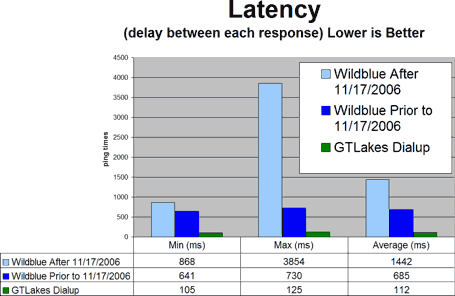
As a result secure sites (online banking, checkout pages, control panels) that require an encrypted connection to protect your private data, credit card numbers, etc. take about twice as long to load as prior to 11/17. secure control panel
dialup: 70.112
wildblue pro: 56.187
wildblue pro 20% faster than dialup
email cp
dialup: 6.531
wildblue pro: 4.442
wildblue pro 32% faster than dialup
selection page
dialup: 5.766
wildblue pro: 4.609
wildblue pro 20% faster than dialup
stats
dialup: 110.375
wildblue pro: 41.188
wildblue pro 62% faster than dialup
phpbb under https
dialup: 29.484
wildblue pro: 31.470
56k dialup 6% faster than wildblue pro
bank main page
dialup: 70.141
wildblue pro: 44.141
wildblue pro 37% faster than dialup
bank sign in
dialup: 31.000
wildblue pro: 23.000
wildblue pro 25% faster than dialup
bank account information
dialup: 85.562
wildblue pro: 44.406
wildblue pro 48% faster than dialup But, while not as good as it was previously, it's still better than dialup, even on secure sites. On non-secure sites, downloading updates, or listening to streaming music, it's a night and day difference. And raw speeds for sending or downloading medium to large files, photos, video, and music remain very good and very close to advertised (46x faster than dialup to download, and 12x faster than Beaver Island dialup to upload a medium to large file.) 
At this time my conclusion would be: - if you're desperate for a better connection today and money is not an object, go for it. Ask in advance: "if performance is not good on the current satellite due to the increased latency, how much it will cost in the spring to change to the new satellite?" I still have not a single regret about the money spent on wildblue as it is very nice to have when compared to dialup.
- if possible, wait until the new WB-1 satellite is operational for customer accounts in March/April of 2007, when presumably the same great performance we saw from 2005 until earlier this year can be restored with new gateway equipment and ample satellite bandwidth.
- if you don't need broadband yesterday and can wait a few weeks to a few months, wait for the much better low-latency wireless connections currently being proposed by both OnWeb90 and NGWireless. OnWeb90 visited the Island today for more site evaluations and a tower climb, and they are very positive about being able to implement a real-world solution that will impress everyone, quickly.
WildBlue Firmware Update Stalls Beam 17
November 19, 2006 On 11/17/2006 a firmware update was pushed to wildblue modems that reduced performance by 50% compared to the previous 13 months of service and introduced a number of glitches even browsing due to frequent stalls and 4,000+ ms pings. Based on the past year of excellent service, I believe this can be fixed, but until this problem is resolved, I would not recommend a new wildblue install in this area.
Another NLOS Wireless Project
November 15, 2006 NGWirless, Inc. a company based in Mason Michigan and directed by Brian Tort also has expressed interest in providing a Wireless Broadband solution for Beaver Island with a visit to the Island on 11-15. They pledge "Internet access to benefit year-round residents and travelers to the Island. Service to be available by April 1, 2007" www.ngwirelessinc.com
NLOS Wireless Project Underway
November 10, 2006 After visiting the Island in October, a neat company from Grand Rapids On Web 90 has placed Beaver Island on thier upcoming project list for wireless broadband Internet. Plans include 1.5down/256up, 3.0down/512up, 5.0down/768up residential plans as well as 1.5/1.5 and 3.0/3.0 commercial plans. Voice Over IP is also part of the package, thus providing phone saving as well. "While keeping the pristine beauty of the Island intact, OnWeb90 is bringing them a complete Wireless network, including VOIP service to the entire island." www.onweb90.com WildBlue Status
May 2006
WildBlue's competition in the marketplace has now caused HughesNet (formerly Direcway) to offer comparable low pricing on their entry level systems; having two options can only be good for we consumers! Wildblue performance remains strong and steady. There have been a few maintenance windows in the early a.m. hours and I do wish they would announce these formally, but other than this the WildBlue connection remains steady and I have no regrets choosing WildBlue. WildBlue speeds on 5-25-2006 are right on the money: Download Speed:
Connection is:: 1567 Kbps about 1.57 Mbps (tested with 2992 kB via testmy.net)
Upload Speed:
Connection is:: 250 Kbps about 0.25 Mbps (tested with 2992 kB, via testmy.net)
WildBlue Performance Update
February 2006 As Beam 17 (serving Beaver Island) is now filling up, speeds are not quite as high now during daytime prime-time hours as when the system was installed in September, but it is still a night-and-day difference compared to GTLakes/BIIP dialup when any images or file uploads/downloads are involved in browsing or working online. Here is the current average performance of my Wildblue Pro system vs. v.92 GTLakes/BIIP dialup on Barney's Lake road. (also note real-world speeds over "56k" dialup are lower than one might expect as the connection adjusts to line conditions after the initial connect.) 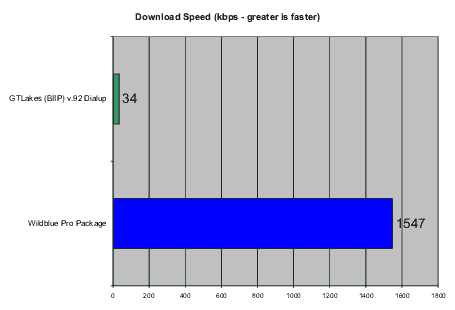
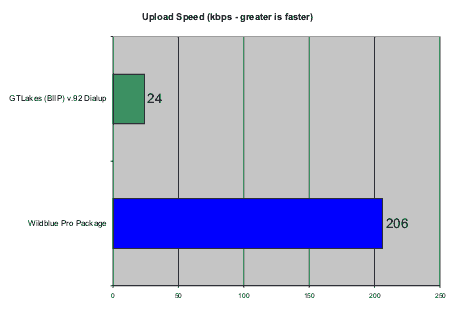
Performance is very very steady on the download side 24 hours a day still, but as of February 2006, upload speeds (which were very steady from September 2005 through January of 2006) seem to frequently be in the 150-200 range during peak usage hours and then in the 210-240 range off-hours. It's not quite as fast as it was prior to January, but as of February 2006, is still a very good value in my opinion, and much faster than dialup. (To get similar performance, an alternative is a Direcway 7000 Small Office system at $999 setup and $99/month vs. Wildblue at $299 setup and $79 a month. Note that the Direcway system does allow an upgrade to a Business Internet account at $199/month for 2000 kbps down and 512 kbps up, but this is more than most are willing to spend. Also of interest is that with Wildblue you can start with a Value 500 kbps down/128 kbps up account on the same hardware that can support 1500/256.) For comparison, here is the time required to download a 1 MegaByte file using both local dialup and then Wildblue. 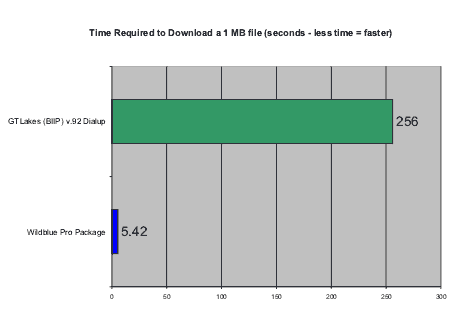
And here is the time it takes to send a 1 MB file over both systems: 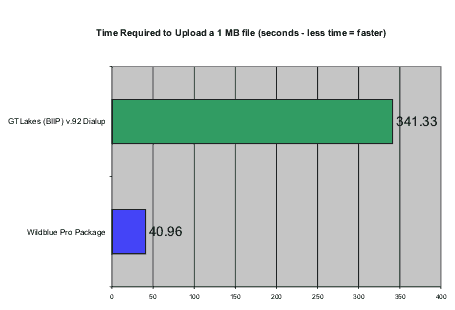
WildBlue up and running on Beaver Island and delivering best ever out-of-town Internet
October 2005  After another wonderful summer, with the shorter days of fall ahead my thoughts have once again turned to how to get faster Internet to make the off-season more interesting and productive. After another wonderful summer, with the shorter days of fall ahead my thoughts have once again turned to how to get faster Internet to make the off-season more interesting and productive.
Last spring we hoped Maylone Enterprises would bring broadband beyond the line of sight currently served by GLE from the school's roof–as we had hoped Wireless First might do. But while interest has been expressed, no one has organized the support necessary to make this somewhat difficult project happen. Referring to a 100-signature petition asking TDS for a solution, Charlene Burnison said "there is a slim chance TDS will consider providing DSL to Beaver Island in the future." Slim is definitely much much better than none, and we are optimistic that a line-based solution might be found that makes this possible on Beaver Island (those interested in Beaver Island DSL should send a quick email to dean.watkins@tdstelecom.com stating their interest) but this is still likely a ways off and not yet a sure thing. A new option however has finally arrived. We've heard about WildBlue since the year 2000, but based on previous ku-band service (Starband and DirecWay) I was skeptical. Early reports of this first US ka-band consumer satellite service were very positive, so I placed an order, and Midwest Energy had a brand new WildBlue system installed and running smoothly in under 3 hours. WildBlue delivers speeds I haven't seen since using a mainland cable modem: a blazing 1550 kbps down (30 times the download speed of dial-up) and 235 to 255 kbps up (7 times the upload performance of Island dial-up) 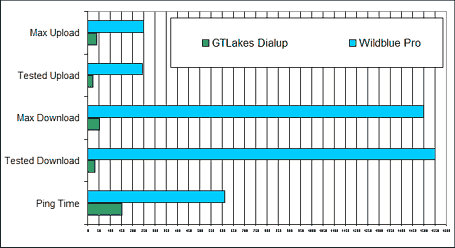
A 10 MB download that takes a half hour over dial-up is finished in under a minute over Wildblue! While there is 625-750 milliseconds of latency due to the distance of the satellite, things that never worked well over previous satellite systems like ftp and secure sites are very fast and reliable over Wildblue. Installs through an NRTC coop are currently subsidized, equipment costs $299, and the monthly fee is $50, $70, or $80, depending on the speed selected–which can be upgraded or downgraded if needed in the future as well. While not as responsive as wireless, this is by far the best always-on 2-way satellite Internet technology I've experienced to date. If you're interested, give the friendly and helpful people at Midwest Energy a call at (269) 445-1112 or 1-800-492-5989, or visit www.wild-blue.coop. –Jeff Cashman, the Beaver Beacon October 2005 Maylone Enterprises Proposed Broadband Link to Include Beaver Island
January 2005 At the December 22, 2004 Charlevoix County meeting an interesting proposal was made by Maylone Enterprises of Elk Rapids, a proposal that could very well become a major stepping stone to Beaver Island's broadband future. Earlier in the fall, Tim Maylone, president of Maylone Enterprises, was asked by the Charlevoix County Sheriff if there were a way to improve its communications between the Sheriff's office, a Boyne City location, and the Beaver Island substation. There was one small problem–there were no additional funds to spend for this in the current budget. Spending time at the County Building, Maylone noted that currently each desk in the County Building has its own phone line, while only a few of the 88 separate lines were actually in use at any given time. In addition, long distance charges to locations such as Beaver Island do add up. When Maylone asserted that a more flexible network could accomplish the goals at hand, and pay for itself and then some, he was asked to analyze the situation and make a proposal. Maylone Enterprises currently provides 32 Internet hotspots, including networks in and around East Jordan and between Mackinaw City and Mackinac Island. Maylone says he is especially interested in providing broadband and wireless service in Charlevoix County as it would fill the gap in his current coverage between Elk Rapids and Mackinaw. Having gained the County's public safety committee's support to go ahead on December 7th, at the December 22nd County meeting Maylone proposed a strategy combining conventional T1 lines with high-capacity wireless, including wireless broadband links to the Boyne and Beaver Island locations. In addition to providing the desired broadband data connections between the Charlevoix County building, Charlevoix Sheriff's Office, Boyne, and Beaver Island substations, a control box would be placed at each location allowing users the option of automatically making Voice Over Internet Protocol (VOIP) connections to greatly reduce long distance costs. When not possible, it would automatically fall back to the traditional POTS line at each location. Maylone secured private investment to fund all equipment and installation costs so the County would not have to pay any up-front costs, and estimates that "after factoring in the early termination penalties for higher-priced current telcom contracts (which would be made unnecessary by the new infrastructure), even in a worst case scenario the County would begin saving $1,300 per month, the very first month, by utilizing the new system." And "in a best case scenario, as the transition progressed, the savings could grow closer to $2,000 per month" while providing enhanced linkages between the four locations. At this point the issue was sent to committee to put together a new RFP, so it is somewhat unclear what the next month will bring or what the rollout schedule may be. If the County does ultimately decide to go ahead with the proposal from Maylone Enterprises, it could be exciting news for the Island as Maylone has expressed a strong interest in moving forward to provide much more for the Island's community in general. As Maylone works on securing tower space on the mainland for an Island connection, he says, in the future he would like to provide not only fast broadband access to more people than can currently see the school's roof, but more, states that this could be "the cornerstone for also providing better telecommunications for medical applications, Internet2 access for the Island schools, public safety, alternative phone services, and alternative commodities broadband Internet access on Beaver Island." New Dialup Options and Hopefully Beaver Island Broadband Options Soon.
August 2002 Update: Thank you very much to GLE for doing a wonderful job with the local dial-up switch over, complete as of August 28th, 2002 at 10:00 am, a couple days ahead of schedule even. Those on the Island will now find they are able to connect in the high 40's (45-48 kbps) with compression, instead of being limited to uncompressed 31.2 as we were for the past few years when connecting to BIIP. It does make for a noticeable improvement as expected. Very good job on the Island dial-up GLE, and a big thank you! One small disappointment is that the wireless system (which is great, delivering 300-700 kbps both ways, always-on) is only able to reach 1 mile, not 9 as reported last month. The 9-mile radius mentioned by GLE is under ideal circumstances without any trees and with a tower, and here with the low antenna on the school, 1 mile is the furthest the system is able to reach (as was reported correctly in the spring). Hopefully newer wireless technology (which is starting to emerge, but has yet to be installed by GLE in any of their 15 or so wireless sites) or a tower near the School will enable more people to access the wireless system in the future. Update: Previously we believed that there would be two great new options for local dialup come September 1st: GLE and BIIC. But recently Tim Dwyer of Traverse Technologies and the Beaver Island Internet Company (BIIC) announced with a press release that BIIC will not be rolling out its own local dialup system because he believed they did not receive enough support to launch successfully given provisioning delays which would cause a delay in the availability of the BIIC system past September 1st. Although we have very high hopes for GLE and are overjoyed that they will soon be offering service, it's also unfortunate that BIIC was not able to launch at this time as it's always nice to have options and new local businesses (for example, while GLE says they will support multilinking, satellite, and wireless within a 1 mile radius of the base station, BIIC may have used the faster v.92 modems for those who prefer the low cost of dialup.) Update: BIIP subscribers received a notice that a decision has been made and GLE will be taking over the BIIP dialup customers by September. GLE will be replacing BIIP's existing 24 dialup lines with 48 lines. Hopefully GLE will also allow customers to connect at 56k rather than 31.2 k which would be slight but noticeable improvement in download speeds at least. GLE also said they will offer wireless access to the harbor area, and also within a 9 mile radius of the wireless base station if you can get a clear line of sight to the base station. More details on the GLE's wireless system will be announced shortly. Broadband might still come to Beaver Island Wireless First Broadband Access Proposal
Here's a rough outline of the Wireless First plan & preliminary timetable for cable modem and wireless access for Beaver Island (though this is been moved back by a few months now): - Do engineering plan and shopping list for high bandwidth link to the island (probably 10 Mbps)
- Come to island May 16 to scout tower sites and assess the cable TV system. Also look at CMU and possible fiber links on island.
- Order equipment and install the link in June.
- Order and install cable headend in late June or early July.
- Meanwhile the Pointred wireless system will be here next week so we can begin evaluation.
- Install wireless system in August.
Wireless First will be able to provide T-1 Internet access to large customers (schools, etc.) for $1000 per month complete. This link would tie directly into their router. Wireless First would deliver via fiber or point-to-point microwave. Customers would provide or pay for router.
Wireless First's cablemodem and wireless residential systems would have variable download speeds and 3 pricing levels: Residential sites: Commercial sites with 1 workstation: Commercial sites with network and shared IP: Each additional IP address is $15/mo.
Cablemodem install is $99 and the single user modem costs approx. $200. Lease the modem for $5/mo.
The commercial modem (multi-user with 4 port hub and firewall) costs
approx. $1000. Lease for $25/mo.
Wireless install is $199. Modem will cost $700 or lease for $15/mo. For
networks add a small office router for $200. For more information, contact Jeff Forrest, jforrest@speedconnect.com
(231) 922-2367 or fax (231) 922-2370. Community Internet Technology Forum
Spring 2002 A few years ago, an interesting thing happened to us on our way to the twenty-first century. In an effort to make Internet service affordable to the Beaver Island School, the original partners of the Beaver Island Internet Project (the School, CMU, and the Medical Center) decided to offer Internet service to everyone on Beaver Island. At that time no one knew what kind of demand there would be. It was hoped twenty or thirty subscribers could be found, enough to help defray the cost.
In a few short years, the number has grown to a hundred and fifty. Early on, the system seemed clogged, but for each upgrade of the equipment more new subscribers appeared, and the degree of clog seemed constant. A little use of the Internet bred a great appreciation for it, even a dependence, and the problems were responded to by grumbles, complaints, and anger. Either they couldn't get on, or couldn't stay on, or had a connection that seemed worse than before.
The Project was besieged with calls for help. It had neither the time, experience, personnel, or budget to help with this plethora of problems. It was wilting under the attack of disgruntled subscribers: this was not anything it had bargained for. It began to hope some benevolent alternative service provider somewhere could be induced, tricked, or bribed into picking up the slack.
On Wednesday night, fifty-seven interested Beaver Islanders heard the good news: it was no longer a question of whether or not someone could be found, but of which of at least three viable candidates we thought would do the best job. After Denise McDonough's introduction, Chuck Schmidt briefly addressed the nature of our dissatisfaction with the current system. Then the three representatives of viable alternates made their presentations.
Dave Hanchett of Great Lakes Energy was first, although he was preceded by an assistant who ably read some generic facts. Dave had two options: he could offer anyone right now a satellite connection to the Internet. They would have to purchase equipment, a dish, which would cost about $700. Service would cost $70 a month. A better possibility was that GLE would replace BIIP. We had reached the minimum number of users to induce this, 150, so if we accepted GLE, they would operate 48 modems out of the School (if the School let them do this, it would receive free access) and charge the same as BIIP: $20 a month. While he did not promise to station a man on the Island to take care of problems, he did say that he would provide 24/7 phone support with a live operator.
Charlene Burnison of TDS took the stand next. She said that her minimum number of subscribers was 300, but in this case she would make an exception. In her brief presentation, she indicated that TDS could offer the same dial-up service as GLE. Their modem base would be moved to the mainland, where it would be easier for them to service.
Jeff Forrest of Wireless First spoke next. He has already played an Island role by providing the Beaver Head Lighthouse school with a microwave relay, providing them with always-on, high speed Internet access. He sketched in a two-part plan. First, he would use the existing TV cable (owned by Pine River Cable, whose owner, John Metzler, was unable to attend) to provide everyone it reaches with high speed always-on Internet service at $40 to $50 a month. He described this as an easy to accomplish goal technologically and could do this by the summer. For those beyond its run, he would lease tower space on an existing tower for a wireless transmitter and provide always-on wireless access for about the same amount per month. The wireless installations would cost about $200 for the antenna, and using new NLOS technology would not require a direct line-of-sight. His system would establish a network in which each antenna on each individual customer's home helped propagate the signal to and from the tower. So his combination of wired and wireless would provide much better and faster service (for a little more than twice the current cost.) After this presentation, Island resident and Internet designer Jeff Cashman spoke about the problems of a satellite connection through Starband. While download speeds were great for large single file downloads, upload was not, and the current 2-way satellite solutions, both Starband and DirecPC/Direcway/Peagasus/Earthlink, are not good for doing business or interactive activities. E-mail is slower than BIIP. Secure pages (for example online banking or checkout pages when you order something online) are also slower than BIIP, and the inherent high latency of a Satellite connection makes activities like VPN, Telnet/Shell access, interactive activities, and gaming impractical over a satellite connection. In addition, there were weather interruptions, and service was less than adequate. The cost was $700 for equipment and installation and $70 a month. As a positive note, the always-on connection is a very nice feature, and once you have an always-on connection, you will never want to go back to a dial-on demand situation. If there were no other high speed options on the horizon, Satellite might be a high-cost partial solution for someone primarily interested in downloading and an always-on connection. But he did not recommend proceeding in this direction if a wireless solution was a possibility.
After these presentations, this question was asked: how do we decide which of these systems would be best for us? Kitty McNamara said that the BIIP Board had asked Internet consultants to submit proposals to them detailing how they could help answer this by investigating these and other proposals. Three such consultants were in the audience: Fred Trimble of Trimble Consulting in Traverse City, Chris Pease of Tech Progressive in Charlevoix, and Tim Dwyer of Traverse Technologies on Beaver Island. Kitty said the BIIP Board would evaluate their proposals and award one of them a contract, with their report due by June.
Ed Wojan said that this was such an important issue that he hoped other organizations would play a role in making this decision. He wondered if a committee could be formed to include all three consultants. They were asked if this was feasible, and could think of no immediate objection. But Kitty said funds were limited, unless the Townships, considering the significance of this matter, would kick in something—and here she looked pointedly at Don Vyse. He was not in a position to commit to this, whereupon Ed Wojan said he would donate a thousand dollars to such a committee to start the ball rolling.
During the discussion that followed, questions of many sorts were answered, and everyone came away with a better understanding of the issues. There was a surge of good feeling over the fact that instead of facing a possible curtailing of our link to the world wide web, on which so many of us rely and which is growing exponentially in importance for the future of this otherwise-cut-off island, we have several viable options, each one of which promises to improve our connectivity, and lives. (Watch for more news soon, and if you have any questions, concerns, or ideas, I would very much like to hear from you. jcashman@beaverisland.net |